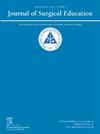How Is Art Used to Train Surgeons? A Survey of 198 Surgery Residency Program Directors
IF 2.6
3区 医学
Q1 EDUCATION, SCIENTIFIC DISCIPLINES
引用次数: 0
Abstract
Background
Art engagement during surgical training often occurs informally and is difficult to characterize. The purpose of this study is to understand practices of surgical educators in using visual aids for teaching encounters, if program directors consider artistic aptitude when assessing residency applicants, perspectives regarding the incorporation of art into surgical training, and barriers that may exist toward the development of visual art curricula for surgery residents.
Methods
A survey study of all general surgery, orthopedic surgery, neurosurgery, otolaryngology, urology, vascular surgery, and cardiothoracic surgery program directors in the United States was conducted from September 2022 to June 2024.
Results
Responses from 198 program directors indicate that residencies rarely participate in graphic design courses (1.5%), visual abstract training (2.5%), art museum visits (3.5%), drawing activities (6.1%), or art related social events (15.7%). Sixty-six percent reported that they either “often” or “always” draw for patients to explain diagnoses. Forty-two percent considered having drawing skills to be favorable among residency applicants. Seventy-four percent answered that the ability to draw may be related to technical skills. Eighty-two percent considered that the ability to draw the steps of an operation was related to having the ability to perform that same operation. Barriers to incorporating art into training included lack of expertise, time, resources, and evidence.
Conclusions
Resident opportunities to participate in organized art-related activities through their surgery programs are rare, but survey responses indicate that program directors do perceive that there is value in art-related exercises for surgical trainees. Future studies ought to consider the effectiveness of incorporating different types of art-based teaching strategies for resident learning.
如何用艺术来训练外科医生?对198名外科住院医师项目主任的调查
背景:外科训练期间的艺术参与通常是非正式的,很难定性。本研究的目的是了解外科教育者在教学中使用视觉辅助的实践,如果项目主管在评估住院医师申请人时考虑艺术天赋,关于将艺术纳入外科培训的观点,以及可能存在的障碍,以发展外科住院医师的视觉艺术课程。方法对2022年9月至2024年6月美国普外科、骨科、神经外科、耳鼻喉科、泌尿外科、血管外科和心胸外科的所有项目主任进行调查研究。结果198位项目总监的反馈显示,驻院艺术家很少参加平面设计课程(1.5%)、视觉抽象培训(2.5%)、艺术博物馆参观(3.5%)、绘画活动(6.1%)或与艺术相关的社会活动(15.7%)。66%的医生报告说,他们“经常”或“总是”让病人解释诊断结果。42%的人认为拥有绘画技能在住院医师申请者中是有利的。74%的人回答说,绘画能力可能与技术技能有关。82%的人认为,绘制手术步骤的能力与是否有能力执行相同的手术有关。将艺术纳入培训的障碍包括缺乏专业知识、时间、资源和证据。住院医师通过其外科项目参与有组织的艺术相关活动的机会很少,但调查结果表明,项目主管确实认为与艺术相关的练习对外科受训人员有价值。未来的研究应考虑将不同类型的艺术教学策略纳入居民学习的有效性。
本文章由计算机程序翻译,如有差异,请以英文原文为准。
求助全文
约1分钟内获得全文
求助全文
来源期刊

Journal of Surgical Education
EDUCATION, SCIENTIFIC DISCIPLINES-SURGERY
CiteScore
5.60
自引率
10.30%
发文量
261
审稿时长
48 days
期刊介绍:
The Journal of Surgical Education (JSE) is dedicated to advancing the field of surgical education through original research. The journal publishes research articles in all surgical disciplines on topics relative to the education of surgical students, residents, and fellows, as well as practicing surgeons. Our readers look to JSE for timely, innovative research findings from the international surgical education community. As the official journal of the Association of Program Directors in Surgery (APDS), JSE publishes the proceedings of the annual APDS meeting held during Surgery Education Week.
 求助内容:
求助内容: 应助结果提醒方式:
应助结果提醒方式:


